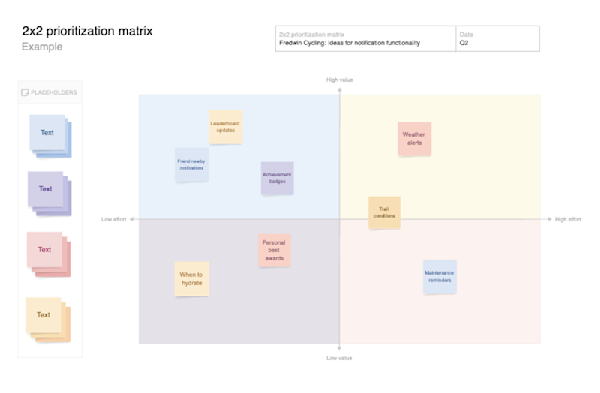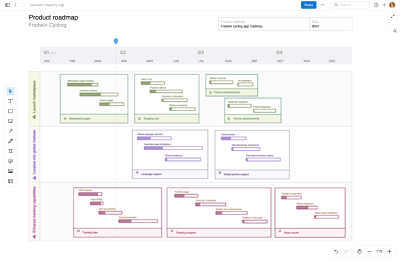Capture learnings and connect them to strategic product decisions in Aha! Discovery.
Product innovation is not limited to new features. It includes every touchpoint across the customer journey: onboarding, adoption, support, and renewal. These touchpoints make up the Complete Product Experience (CPE). When you stay close to your customers throughout their journey, you are more likely to build something they will value and keep using.
That kind of insight requires more than good instincts.
You need clear processes and the right tools to connect what you learn to what you build. Aha! Discovery and Aha! Ideas give you the structure to gather feedback, run interviews, synthesize findings, and tie everything back to your roadmap.
Related:
Top
35+ customer questions for product innovation
Use the questions below to guide discovery and fuel innovation. They are grouped by customer touchpoint, with notes on what each line of questioning can reveal. Keep in mind that you do not need a formal research study to uncover valuable insights. Use these questions in casual conversations and share them with customer-facing teammates. Everyday interactions can be just as revealing as structured interviews.
When someone is actively considering your product
Questions to ask | • How would you describe a productive or successful workday? • What tools do you use to get things done? • What are your business goals for the next year? • What is currently holding you back from achieving these goals? • What problems do you encounter in your daily work? • How have you tried to solve or work around these problems? • What prompted you to search for a new solution? • How did you first hear about our product? • What kind of information helped you learn more about our product (e.g., articles, videos, referrals)? • What is the primary benefit of our product that stood out to you? If they have done a trial or demo: • What made you decide to sign up for a trial or demo? • Has your trial or demo experience influenced how you feel about our product? If so, how? • Which features or areas do you feel most uncertain about? • Is there any functionality that you are interested in exploring further? Pro tip: Pair these questions with data from your trial signups, marketing analytics, or demo follow-ups to get a fuller picture of customer behavior and intent. |
What these questions reveal | Understanding why someone chose your product helps validate that you are solving real problems. |
After someone has purchased your product
Questions to ask | • What other solutions or tools did you consider in your search? • Why did you ultimately choose to purchase our product? • Who helped you to make the decision to purchase our product? • When getting started, which parts of our product were easiest or most intuitive? • Which parts felt confusing or difficult to use? • What problems are you currently trying to solve by using our product? • How does our product compare to your previous solution so far? • What is the biggest benefit of using our product right now? • What is the biggest challenge or pain point you experience with our product? • What do you hope to accomplish in the next six months of using our product? |
What these questions reveal | This is the time to build empathy, learn what is working, and surface opportunities to improve. |
During account reviews and renewals
Questions to ask | • Has our product helped you get closer to achieving your goals? Why or why not? • Which problems have you been able to solve by using our product? • What problems exist that still need to be solved? How have you tried to solve them? • If you could remove or change one thing about our product, what would it be? • If you could add or improve one thing about our product, what would it be? • Which aspect of our product is the most valuable to you today? Which is the least valuable? • If our product disappeared tomorrow, how would you feel? • Have you felt supported when running into issues? Is there anything we could do differently to improve your experience with sales or support? • How would you rate your satisfaction with our product overall? • Would you recommend our product to others? Why or why not? If a customer does not renew: • What is the main reason you decided to no longer use our product? • What is one thing that would make you reconsider our product in the future? • Did you choose an alternative solution? What does it offer that our product does not? Pro tip: Log these conversations in your discovery workspace. Reviewing customer sentiment over time can help you refine your roadmap and reduce churn. |
What these questions reveal | Renewals and departures are key moments to understand what drives decisions and how you can improve. |
About new product adoption and value
Questions to ask | Does this type of functionality excite you? Why or why not? If this product feature were available today, would you use it? Why or why not?
If a customer has tried the new functionality: What was your initial reaction? What did you find confusing or difficult to use? What felt easy or intuitive? What task did you spend the most time doing with the new feature? Which part of the features did you rarely use? Why did you choose to do one action over another? Will this feature enhance your current workflows? Why or why not? If you had a magic wand, what would you change about this feature?
|
What these questions reveal | New functionality offers a chance to uncover fresh insights and strengthen the product experience. |
Remember: These questions are not interview scripts. They are prompts to help you think more broadly about what a meaningful conversation could look like. Use them to guide your curiosity across a range of interactions, whether you are leading a research study or chatting with a customer in a renewal call. The goal is to stay open, ask thoughtfully, and keep listening.
Related:
Top
Tips for better customer conversations
Even thoughtful questions can fall flat if the conversation does not feel natural. Focus on building real rapport and give customers room to share freely. A few simple techniques can help:
Follow up with curiosity: Ask "why" more than once and in different ways. If a customer shares a preference or behavior, try questions like, "What led you to that?" or, "Can you tell me more?" These explore deeper motivations.
Repeat what you heard: Summarizing in your own words can clarify vague responses and show that you are listening closely. It also gives the customer a chance to confirm or refine what they meant.
Leave space: People often reveal more after a moment of silence. Give space for the customer to reflect and elaborate — do not rush to fill the gap.
Ask for real examples: Stories and specifics are more valuable than abstract opinions. Prompt customers to walk you through what happened or how they solved a problem.
When customers feel heard, they are more likely to share what they really think. That is where the best insights begin.
Related:
Product discovery is an ongoing process — not a single moment or method. The conversations you have today can reveal the ideas that shape tomorrow’s product. But that only happens when customer feedback is part of a structured approach to learning and decision-making.
Aha! Discovery helps you plan and run research, synthesize findings, and connect insights directly to your roadmap. Aha! Ideas makes it easy to collect and evaluate customer feedback at scale. Together, they give you a system for turning insights into real innovation.
Use the questions in this guide to spark deeper conversations. And then put what you learn to work.



